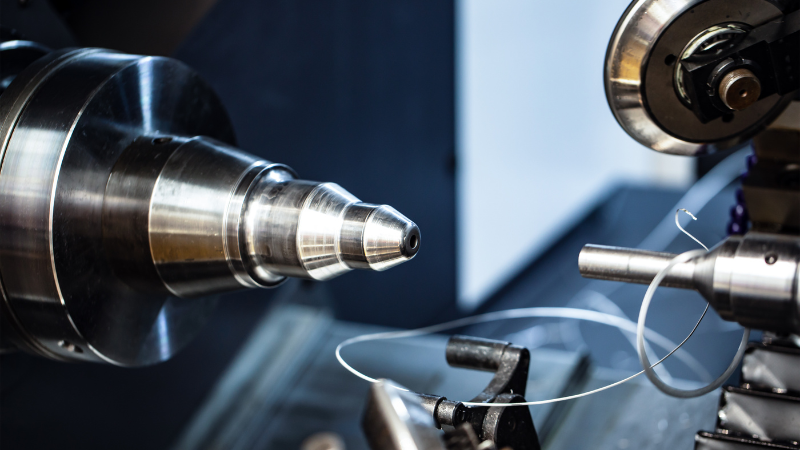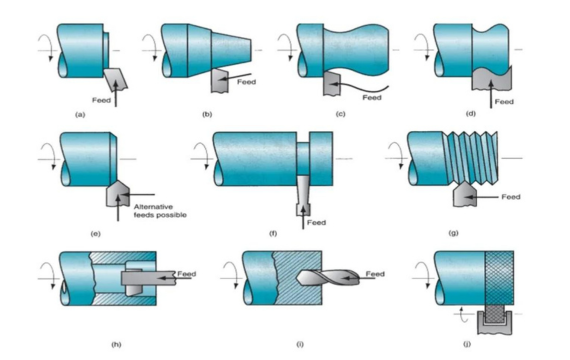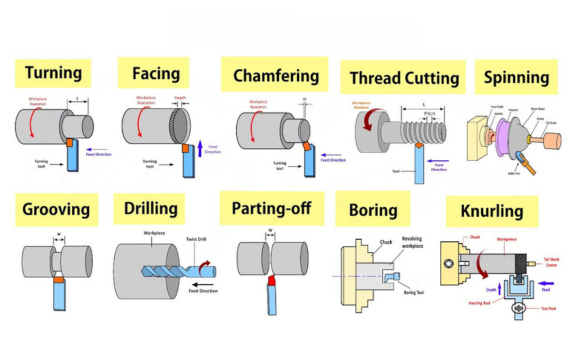Machine turning is a robust machining process you can use to make many parts from different materials.
It is a general term referring to a wide range of processes which include threading which gives you bolts and contouring, which gives you contoured components.
In this guide, you will learn everything about machine turning process:
What is Machine Turning?
Turning is a distinct process that subjects your revolving piece of raw material to a lathe that sculpts specified designs on your workpiece. This leaves you with a finished component whose form meets your expectations.
This machine-backed process shrinks your physical burden while ensuring consistency in the quality of your finished workpieces.

Key Steps in Machine Turning Process
Do you ever wonder how the threads on your car’s bolts are imparted or how its engine components are generated?
Well, the answer lies in machine turning, which only necessitates a specialized lathe. Here is a breakdown of this process:
Step 1: Preparation
Before getting your lathe rolling, you need to ready your workpiece and set up your turning equipment and parameters. Here is everything you need to do to prepare for turning;
· Choose your Preferred Workpiece Material
Begin by settling on the type of workpiece, you will be machining. What material will it be made of? Will it be plastic, wooden or metallic and how strong do you need your finished workpiece to be? When making your selection, have in mind the final product you intend to produce.
· Condition your Workpiece
Secondly, procure your bulk workpiece and slice it into smaller pieces, which can fit into your lathe machine.When sub-dividing your block workpiece, make sure that your cut pieces are comparatively bigger to account for the material that will be shaved off.
· Ready your Machine
To conclude your preparations, set up your lathe appropriately to prepare it for the specific turning operation you intend to execute. First, check on the condition of its essential components such as the cutting tool. Make certain it is in tin-top condition and well-positioned.

Step 2: Turning Operation
Now that you have laid the necessary groundwork, proceed to set the wheels in motion.
Begin by instructing your lathe to run a specific turning operation and the timeline in which it should execute the specified operation. Once you are done with the set up, get your machine rolling.
This will initiate spindle rotation, which will consequently revolve your workpiece. Subsequently, your designated turning tool will be lowered towards your workpiece resulting in the siphoning out of material fragments. This material removal will ultimately result in the creation of your final components.
Step 3: Polishing
After your lathe has executed its tasked operation, you can instruct it to refine your component if you are not satisfied with the results generated. For instance, if the quality of surface finish is rougher than you would like, you can initiate a surface polishing operation to get rid of the roughness.
Step 4: Assessment
As your turning machine runs, have one of your trained operators check up on its progress periodically. This will help avert cases of misaligned cutting and undesirable results. Here are some of the parameters you should instruct your operator to focus on:
- State of your turning tool. Is it worn out?
- Positioning of your cutting tool. Is it precisely positioned?
- Amount of chips generated and if they are interfering with the turning operation.
Step 5: Workpiece Detachment and Unloading
Conclude your turning operation by detaching your machined components to generate individual parts ready for packaging. To execute this, use a parting tool, which will ensure your components are detached carefully thus preserving their dimensions. Consequently, offload your individual components and prepare them for packaging.

Advantages of Machine Turning
The reward of machine turning not only lies in the essence of the components it generates but also on their quality. As you produce simple parts like screws or sophisticated components like engine pistons using distinct turning operations, you are guaranteed the following benefits:
· Fast-Paced Production
Imagine the hours you would have to put in to thread a piece of metal by hand. Now imagine executing the same task using a CNC lathe machine and compare your throughput. Machine turning increases your throughput tenfold.
· Uniform and Steady Quality
This process first eliminates the risk of human error, consequently guaranteeing you high-quality components. These components bear a uniform resemblance thanks to the machine’s ability to replicate your turning operations.
· Versatile Material Handling
You can sculpt components of varying materials ranging from wood to metal using your lathe. All you need is a customized cutting or turning tool.
· Diverse Geometries
Whether you are looking to sculpt a complex or simple geometry into your workpiece, turning has you covered. You can even craft a complex aerospace component with ease and utmost accuracy.
· Polished Surface Finish
Forget about components with rough patches, which can be a functional hindrance and an eye sore. Machine turning promises you polished surfaces that will elevate the quality of your finished components.
· Operator Safety
Threading a hole into a metal block by hand comes with a risk of bodily harm. Using a specialized lathe, on the other hand, eliminates this risk. All you need is the appropriate safety gear.
· Reduced Staffing Costs
Machining a block of metal manually can take hours or even days and this will translate into more human labor. This can be costly compared to relying on machine turning, which necessitates minimal human intervention.
· Diminished Scrap Costs
Machine turning will help you eliminate the possibility of defects thus saving you material wastage, which can be quite costly.
Most Common Machine Turning Operations
Thanks to the broad array of machining tools at your disposal, it is safe to conclude that machine-turning promises to solve virtually any of your engineering challenges. You can chip into this toolkit of engineering solutions and unearth a customized answer. Key operations you can fulfill include:

· Facing
This turning operation often necessitates you to mount a single-point cutter, which cuts out material from one end of your workpiece. This consequently leaves you with a component whose one side is flat and polished to a smooth finish. Whereas facing is often utilized to prepare your workpiece for other turning operations, you can also utilize it to prepare cylinder and shaft ends.
· Straight Turning
This operation attempts to craft cylindrical components with an even outer diameter. To accomplish straight turning, you will need to maneuver your single-point cutter coaxially resulting in the shaving off of unwanted parts from your workpiece’s outer diameter. You can exploit straight turning to produce parts with uniform outer diameters such as rods and shafts.
· Threading
To undertake this operation, you will need a specialized threading tool to sculpt threads on your workpiece. The threads can be internal or external depending on the intended function of your final component. Thread cutting is a machining operation that will help you produce screws, bolts, and other parts that must bear threaded holes.
· Taper Turning
This turning operation seeks to turn your workpiece into a tapered final component. This component is characterized by a diameter, which shrinks progressively from one end. This type of finish is common in tapered fasteners, plugs, and pins. To undertake taper turning, you simply need to offset your lathe’s tailstock to facilitate uneven-diameter cutting.
· Knurling
Knurling is a turning operation that you can exploit to sculpt decorations onto your workpiece or manufacture components that must be grippy. You will need to load your lathe with a specialized knurling tool that will impart the featured design onto your component.
· Form Turning
Form turning seeks to impart a pre-designed shape or form onto your workpiece. This requires you to utilize a forming tool shaped exactly like the design you intend to sculpt in your final workpiece. This turning operation continues to thrive in the mass manufacturing of knobs, pullers, and gears among other components.
· Chamfering
This revered machine turning operation gives your sharp-pointed workpiece an angled edge thus protecting you from sharp cuts. All you need is a chamfering tool, which will impart an angled design on your component’s sharp ends. This operation can also elevate your workpiece’s aesthetic appearance.
· Contour Turning
This is a rather sophisticated turning technique that necessitates a specialized lathe. Once you perform contour turning on your workpiece, you are guaranteed a final component with a non-linear form. These contours leave your component with intricate designs meaning you can utilize them as decorative pieces.
· Grooving
Grooving comes in handy when you are trying to install narrow slots or grooves into the workpiece. These grooves can be the foundation for further turning operations or final component features. To accomplish this operation, you only need a grooving tool with customized dimensions to ensure your grooves are of the right width and depth.

Commonly Used Turning Equipment
Turning equipment gives us simple components like jewelry as well as complex components like automotive parts. It is however often overlooked. Underneath, we look at the varying turning machines at your disposal.
- Bench Lathe: This is a manually operated machine specifically designed to help you machine relatively small workpieces at a small scale. It, however, requires you to acquire skilled labor, which can be comparatively costlier.
- CNC Lathe: Equipped with computer programmable software, this machine allows you to perform the most complicated of turning operations. It takes precision and production speed to unfathomable levels.
- Turret Lathe: This lathe is engineered to help you improve your throughput. It features a turret, which can secure several turning tools thus allowing simultaneous machining. With a turret lathe, you can perform distinct turning operations, for instance, facing and threading.
- Swiss-Type Lathe: This lathe comes with a simple design but it is capable of machining complex components for distinct industries. Its characteristic precision enabled by its CNC configuration means you can use it to generate small but complex parts.
Limitations of Machine Turning
Machine turning has been revolutionary, to say the least. However, just like any other human invention, it comes with a set of limitations, which include:
- Chip Formation: Turning revolves around the shelving of unwanted parts of your workpiece. This results in the buildup of small fragments, which if not aptly extracted can damage your workpiece or turning tool.
- Vibration: When machining heavy-duty workpieces like metal blocks, you can expect vibrations, which can leave your final product with a rough surface finish. These vibrations can also cause hearing problems.
- Tool Wear: Over time, your turning tool will start diminishing thus necessitating you to replace it. Failure to replace it will lead to poorly formed workpieces.
Products Made with Machine Turning
Machine turning is often overlooked since most people do not understand the role it plays in minuscule as well as colossal industries. This process comes in handy in a myriad of distinct manufacturing industries. It is primarily utilized to produce:
- Prototypes: Prototype metal cams, shafts, and bushings.
- Automotive Components: Pistons, gear components, engine shafts, and rotors among others.
- Construction Equipment: Metal rods, bulldozer parts, and hydraulic cylinders among others.
- Aerospace Parts: Landing gears, turbine blades, and aerospace engine components.
- Consumer Products: Bicycle components, kitchenware, and electronics among others.
- Firearm Components: Receivers, barrels, and slides among others.
Conclusion
As you can see, machine turning is a practical process that you can adopt in many part fabrication processes. You can make a wide range of parts, depending on the type of turning operation.
For all your part fabrication, KDM is your trusted partner in China – talk to us now.
More resources:
CNC Machining Tolerances – Source: KDM
What is CNC Machining – Source: KDM
Types of Machining Processes – Source: XOMETRY




